‘Top Chef: Wisconsin’ Episode 9 recap: Indigenous cuisine and culture in 'The Good Land'
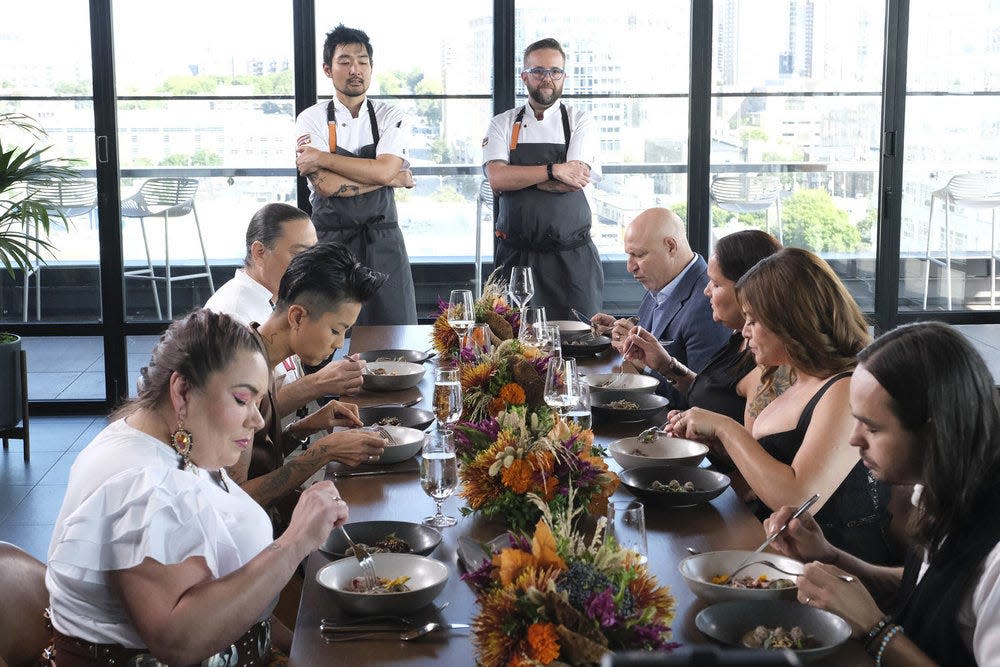
Warning: Spoilers ahead for "Top Chef" Season 21, Episode 9, which aired May 15, 2024.
The Wisconsin season of “Top Chef” has had a ton of fun with challenges that nod to the state’s traditions, from cheese festivals to supper clubs to sizzling sausages at the ballpark. But it was high time for a challenge to pay homage to the people who settled here first, and whose cuisine is egregiously overlooked not just in Wisconsin, but across the globe.
This week, the contestants began with a Quickfire Challenge celebrating a tart, bouncy berry native to Wisconsin, then learned about Wisconsin’s Native American culture through its Indigenous foodways.
This was one of my favorite challenges to date, and though not nearly enough time could be dedicated to the importance of Indigenous food and farming, I’m ecstatic that a platform has been given to promote the food and culture of the people who named this state, this city and called this land home long before most of our ancestors.
Read on to see how the cheftestants honored Indigenous cuisine at the Elimination Challenge, but before you do, here are a few of the sights, special guests and highlights seen around “The Good Land” this week.
Milwaukee’s spotlight moments from “Top Chef,” Season 21, Episode 9
What in MKE did we see?: Fiserv Forum, The Couture, the Milwaukee Art Museum, the ASQ Center building in downtown Milwaukee, Il Cervo, the Riverside Theater, the Mitchell Park Domes, Broadway Street, the 330 Kilbourn buildings (home to the Journal Sentinel), the Milwaukee City Hall clock tower
Celebrity sightings: Minneapolis’ Owamni chef/owner and The Sioux Chef/NATIFS founder Sean Sherman, Wisconsin Dells’ Wild Bearies founder Elena Terry, Rochelle Hoffman of Dempze Cranberry Farm, La Pointe’s Miijim chef/owner Bryce Stevenson, Chicago’s Ketapanen Kitchen Executive Chef Jessica Walks First
Where was the challenge set? Il Cervo Italian restaurant, in Milwaukee’s Deer District
How did Dan do? Fabulous! Dan followed up his big win last week with a top-three finish. Guest judge Sean Sherman praised his resourcefulness in highlighting one major ingredient, and “Top Chef” host Kristen Kish thanked him for creating a foam that actually served a purpose in his dish. He's safe for another week.
Best Milwaukee-related quote: “Did you know that ‘Milwaukee’ translates to ‘the good land’ in the language spoken by the Potawatomi, Odawa and Ojibwe tribes?” — Kristen Kish
After a grueling Restaurant Wars challenge, the remaining eight chefs reflected in the stew room of the Top Chef kitchen.
“I felt that if I was going to make it to the top eight, I was going to be happier,” said Manny, who blamed himself for contributing to Dos by Deul teammate Kaleena’s elimination last week.
His fellow cheftestants attempted to lift his spirits, reminding him that double elimination was on the table, but the judges chose to keep him for a reason.
But everyone was on edge. This late in the game, even the smallest misstep can lead to elimination.
Savannah’s attempt to combat those slip-ups was to map out dish ideas and inspiration written on her hotel room mirror, planning her next steps as the competition moves forward.
With only a few challenges left, intense focus and planning will be key in determining who will win the title of Top Chef.
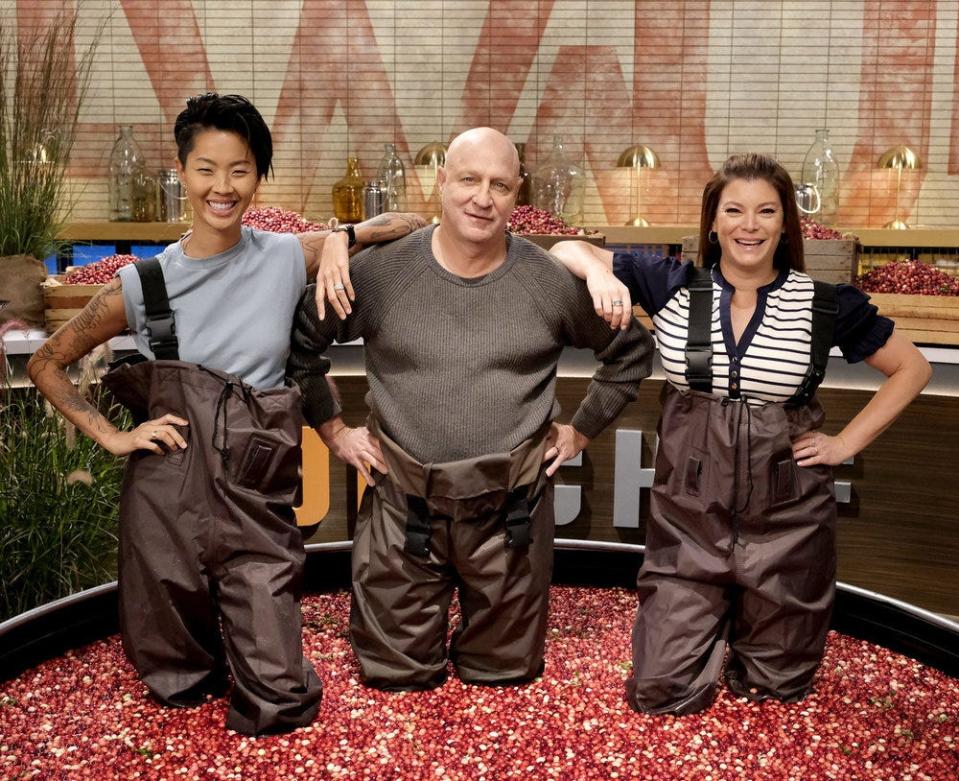
The Quickfire Challenge: Getting bogged down in the kitchen
When the chefs entered the Top Chef Kitchen, they were met by host Kristen Kish and judges Tom Colicchio and Gail Simmons outfitted in rubber waders, standing knee-deep in a makeshift cranberry bog.
It was a fun sight, but we usually don’t see Colicchio and Simmons until much later in the episode. Something was up.
Sure enough, things are about to change, Kish said. From now on, Colicchio and Simmons will be present at the rest of the Quickfire Challenges, and everyone’s dishes presented at the Quickfires will be considered when deciding who stays and who goes home each week.
“This is the face of unhappiness,” said Dan, who’s been vocal about his distaste for Quickfire Challenges from the start.
But maybe he'd feel more confident with a Quickfire themed around his state fruit: cranberries!
“Wisconsin produces the most cranberries of any state in the nation,” said Kish as she announced this week’s Quickfire theme.
The chefs would have 30 minutes to make a dish starring the tart, crimson berries, and would present them to the three judges, as well as Rochelle Hoffman of Dempze Cranberry Co. in Wisconsin Rapids.
The chefs went in all directions with the cranberries, getting creative with ways to balance their tartness, like Soo's beef carpaccio with berry and beet chutney, Manny’s pork tenderloin with brandy and cranberry sabayon, Dan’s salt and pepper scallops with cranberry red curry, and Amanda’s take on chicken and waffles with corn and cranberry hoe cake with fried chicken.
Amanda got bogged down with her dish, placing her in the bottom three, along with Manny and Laura, who presented a grainy-textured cranberry and walnut fesenjan with pork.
The favorite cranberry-forward dishes belonged to Dan, Michelle (whose rich foie gras balanced nicely with tart cranberries) and Danny, whose cranberry-poached sea bass dish impressed with multiple preparations of the berry.
“You were juicing your cranberries,” Hoffman said. “It’s not an easy task.”
Danny claimed the $10,000 prize, adding to his hefty purse of cash winnings, now totaling $43,000 — the most of any contestant left in the competition.
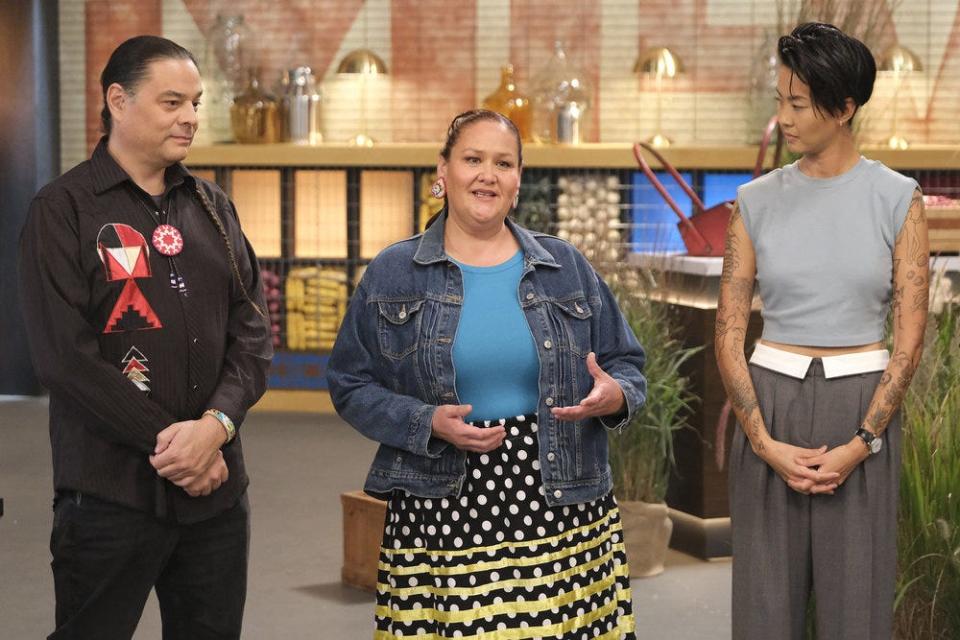
The Elimination Challenge reveal: Good eats in the good land
“Did you know that ‘Milwaukee’ translates to ‘the good land’ in the language spoken by the Potawatomi, Odawa and Ojibwe tribes?” Kish asked the contestants after the Quickfire Challenge.
The Elimination Challenge would honor these and all 11 federally recognized tribal nations that call Wisconsin home. This week, the chefs would need to create a modern dish using Indigenous ingredients native to America, meaning dairy, wheat flour, cane sugar, pork, chicken and beef were off the table.
Instead, they’d use ingredients sourced from Native American farmers and markets.
The ingredients were curated by this week’s two main guest judges: Three-time James Beard Award winner Sean Sherman, an Oglala Lakota chef and activist, and Elena Terry, the Ho-Chunk founder of Wild Bearies, a Wisconsin Dells-based nonprofit that promotes traditional farming techniques.
The chefs would have three hours to prep and cook at Il Cervo in Milwaukee’s Deer District, where they’d serve the five aforementioned judges, plus Chicago chef and Menominee Indian Tribe of Wisconsin member Jessica Walks First and La Pointe chef Bryce Stevenson of the Red Cliff Band of Lake Superior Chippewa (whose Madeline Island restaurant, Miijim, was reviewed by the Journal Sentinel last summer).
Dan perked up instantly when Stevenson’s name was mentioned. Surprise, surprise, Dan knows another guest judge!
“Bryce worked with us,” Dan said. “Bryce is awesome.”
Stevenson began his cooking career in Milwaukee, and worked in kitchens with Dan before moving on to lead Sherman's Indigenous Food Lab in Minneapolis and eventually opening Miijim last year.
There’s always a connection.
A lesson in Indigenous cuisine
For inspiration, Sherman and Terry hosted the chefs and judges with a spread of Indigenous food they cooked themselves, including white bean spreads, smoked walleye, masa chips, wild rice patties, cedar-braised bison, roasted sweet potatoes with dandelion greens and red bean cake.
While eating, the chefs took feverish notes as Sherman and Terry described the ingredients they commonly cook with. Despite their wide breadth of cooking knowledge, none of the chefs had dined at an Indigenous restaurant before.
“And that’s a problem,” Sherman said. “We should be normalizing Indigenous foods, and not just here, but on a global scale, and celebrating these diversities everywhere.”
Despite reaching this stage of the competition, the chefs were sweating over these new-to-them ingredients — and the absence of ingredients they rely on every week — as they brainstormed their dishes.
“I would feel a lot better with a little bit of butter, honestly,” Michelle said.
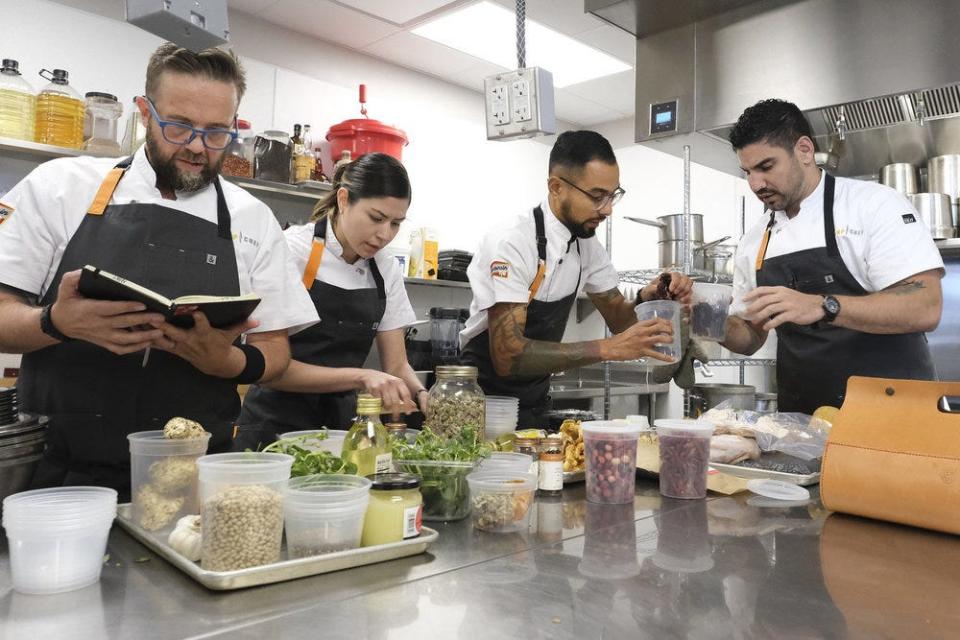
The Elimination Challenge: Indigenous elegance
It was clear most of the chefs were missing their grocery-store standbys.
Savannah scoured the pantry for the sweetest ingredients she could find to help bring together the dessert she’d planned. And though Amanda had cooked with venison previously, elk was a new protein for her. Danny was using a part of the elk he’d never worked with before: elk caul fat, or stomach lining, which acts as a binder when it’s cooked.
But Michelle felt confident using rabbit, an ingredient she’d cooked with many times before, and she planned to tap into her barbecue skills to add plenty of smoky flavor to the game protein.
For Dan, the challenge didn’t lie in the available ingredients, but the strain on his body at this point in the competition. “I’m just getting tired,” he said, his fingers aching from the tedious work of cutting away a sunflower bulb that would act as the star ingredient of his Indigenous dish.
For many of the chefs, it was a “cross your fingers and hope for the best” type of challenge.
In pairs, they brought their dishes to the glass-enclosed dining room at Il Cervo, overlooking downtown Milwaukee.
Aesthetically, these were some of the most stunning dishes presented in the competition so far, with vibrant sauces and elegant presentation that honored the Indigenous ingredients with beauty.
And for the most part, the dishes seemed as delectable as they were lovely to look at.
Soo, who struggled creating gnocchi from wild rice, managed to pull together his dish with the help of a couple duck eggs that helped them hold their shape. “I can tell you this wild rice came from my reservation,” Walks First said. “It’s kind of reminding me of home.” The huitlacoche puree and roasted butternut squash only amplified the comfort of the dish, the judges added.
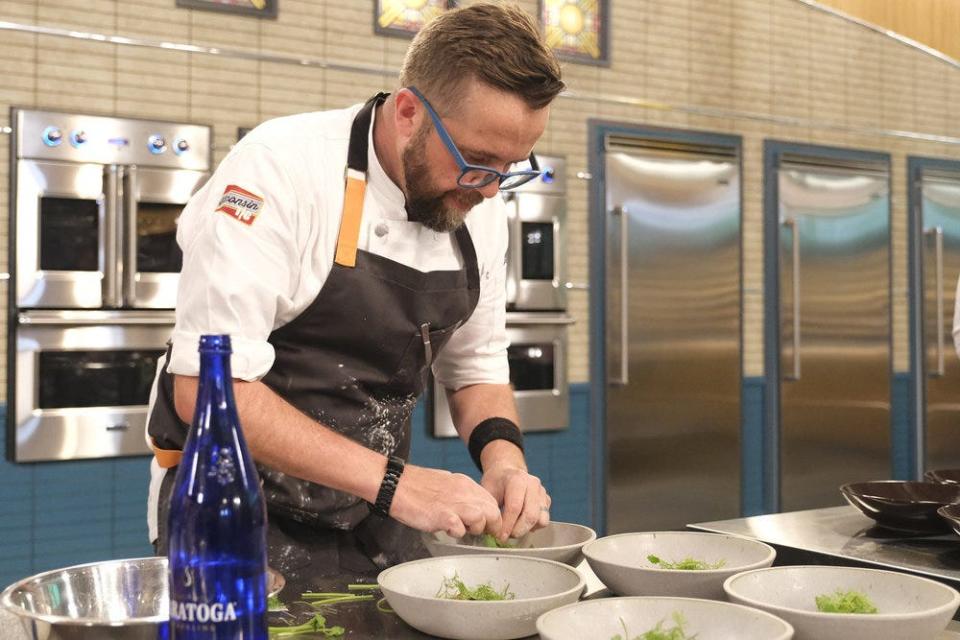
For Stevenson, Dan’s sunflower choke with braised goose and aronia berry puree was a reminder of a past life, too. “I know whose dish this is just by looking at it,” he said, before commenting that he enjoyed how Dan honored the sunflower by using four parts of it in his dish.
Kish added that, for once, she was happy to see foam on her plate. “The foam actually serves a purpose ‘cause it melts into the sunflowers,” she said. “Texturally, it’s such a fun bite to eat."
And Savannah had barely left the room before the judges gushed over her squash and maple jelly cake with aronia berries, grapes and plum jelly.
“It’s amazing,” Kish said. “She nailed the brief.”
“She was letting it tell her what it wanted to be, and it came out to be something really nice,” Sherman noted.
It was a challenge everyone wanted to do right by, Savannah said as the chefs debriefed in the stew room before learning their fates. The honor behind the culture and the native ingredients brought as much pressure to the table as the stress of working with a new cuisine.
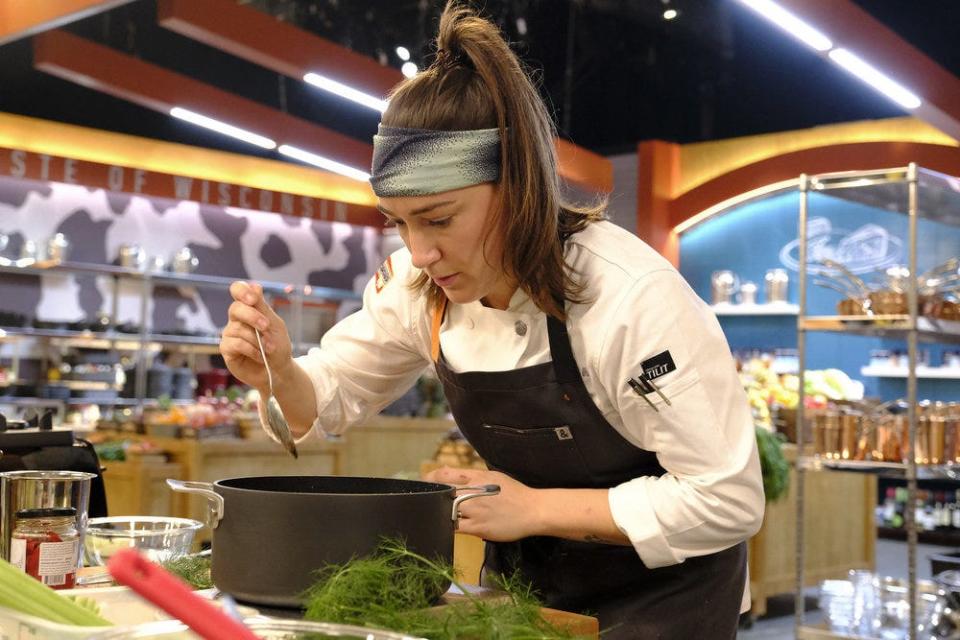
Who won ‘Top Chef: Wisconsin’ Episode 9?
Back in the Top Chef Kitchen, Soo, Savannah and Dan were asked to remain at the judges’ table to hear their critiques. They served the three favorite dishes of the week.
The judges loved Dan’s resourcefulness in using so many parts of the sunflower, were wowed by Soo’s roast squash and its vibrant glaze, and adored the story Savannah’s inventive squash and maple jelly cake told.
“On first bite, it was a mix of pumpkin pie and gingerbread, but the sauces made it something completely brand new,” Kish said of Savannah’s dish, before Terry announced her name as the winner of this week’s Elimination Challenge.
It was Savannah’s first win of the season.
“I guess I should keep making savory desserts!” she said. “I want to keep showing up for myself and showing everyone here what I can do.”
She’ll get an advantage going into next week’s Elimination Challenge.

Who was sent home on ‘Top Chef: Wisconsin’ Episode 9?
Not everyone brought their best to the judges’ table.
An extra roast in the pizza oven dried out Michelle’s rabbit, and her acorn squash polenta cake sogged out under the aus jus she used to try to bring back moisture.
The judges thought Laura’s duck tamal with haroset was all over the place with too many ingredients used in one dish. “It’s not making any sense for me,” Walks First said of her dish.
And although Amanda’s elk was nicely prepared, it was heavily overpowered by the pipian rojo sauce she served with it. Her dish also suffered from an identity crisis. “I felt like it was really disjointed,” Stevenson said. “Is it a tataki? Is it a tartare?”
Theirs were the bottom three dishes of the week, and as the judges deliberated, taking into consideration the chefs’ Quickfire Challenge dishes, they decided Michelle’s foie gras cranberry dish was her saving grace.
It would be a double elimination.
“Laura and Amanda, please pack your knives and go,” Kish announced.
Tears flowed in the stew room when the two eliminated chefs announced they’d be leaving. Nine weeks into the competition, these chefs have become incredibly tight, and the closer the finish line gets, the more devastating losing becomes.
“I feel like I let myself down. I made a bad choice and those decisions are on me,” Amanda said. “But I do have one more life to live in Last Chance Kitchen. I’m going to go as hard as I possibly can.”
She and Laura will both contend with Kévin, who ousted Rasika after a last-minute return to Last Chance Kitchen when Kaleena excused herself from the competition in a shocking twist.
Speaking of twists, next week the remaining six chefs will put their own on two classic Wisconsin food-themed events: the meat raffle (I squealed to myself when they teased the Quickfire!) and the Door County fish boil — and I was there, so stay tuned for some behind-the-scenes stories from the taping on the shore of Lake Michigan.
How to watch 'Top Chef: Wisconsin': TV channel, streaming
Viewers can watch live on Bravo on Wednesday nights at 8 p.m. or stream the next day on Peacock, BravoTV.com or the Bravo app.
This article originally appeared on Milwaukee Journal Sentinel: ‘Top Chef: Wisconsin’ Episode 9 recap: Indigenous cuisine highlighted
